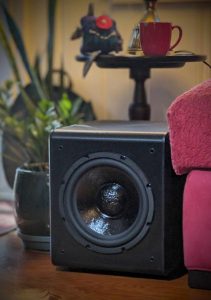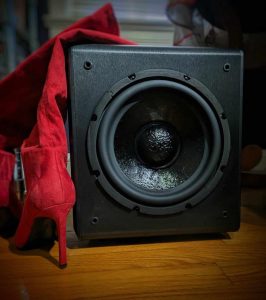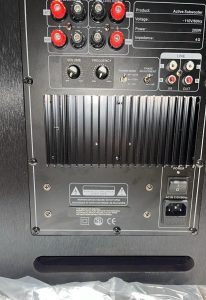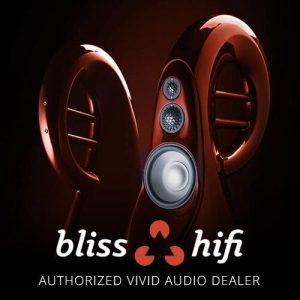Vanguard Caldera 10″ Power Active Compact Subwoofer by Greg Voth

 My early years as an illustrator found me in modest accommodations, perfect for smaller speakers, like Spica TC-50s and 60s. In those small NYC apartments, I learned to prize musicality over bombastic leanings. When we’d been in our loft for several years, we purchased a pair of Eminent Technology LFT-8b. Four years later, then writing for the pages of Stereo Times, the Tekton Design Double Impacts replaced the LFT-8 b’s. Efficient speakers are infinitely easier to use as a review tool, though my wife still yearns for those hybrid ribbons.
My early years as an illustrator found me in modest accommodations, perfect for smaller speakers, like Spica TC-50s and 60s. In those small NYC apartments, I learned to prize musicality over bombastic leanings. When we’d been in our loft for several years, we purchased a pair of Eminent Technology LFT-8b. Four years later, then writing for the pages of Stereo Times, the Tekton Design Double Impacts replaced the LFT-8 b’s. Efficient speakers are infinitely easier to use as a review tool, though my wife still yearns for those hybrid ribbons.

It seems odd to confess, but to this date, I’ve never owned a rig-worthy sub, though it was not without curiosity. Over years, I’d found 3 Velodyne 12″ servo subs at different times in the street and humped each beast home, hoping for good fortune… sadly, none worked or weren’t worth fixing. Even today, after nearly 25 years of life with Robin, I’ve never bothered trying her 12″ home theater sub with any of my rigs. That might prove a bridge too far… she does love her surround gear. Enter the new Vanguard Caldera 10″ Active Compact Subwoofer!
The Vanguard Caldera 10″ Active Compact Subwoofer
What’s in a name? According to Schifter, a “Caldera is a collapsed post Volcanic Eruption – and our new 10″ powerhouse is All That. Amazing Deep and Resounding Reach – this little guy really lets it go and digs deep and yet Incredibly Tactile.” He added “Incredible Tech – Super Performance – Unbeatable Value” [capitalizations, Schifter’s]. Claiming that the Caldera is built like a “tank,” Schifter confirmed the adage with interior photos of the Caldera 10’s workings. The more dependable it’s designed and the better it’s constructed, the better this sub is for everyone – no one wants to freight a temperamental subwoofer back and forth for repair.
I’ve watched the Caldera 10 project develop over the past few months, from early photos and renderings on Mark Schifter’s Facebook page to the physical product now in hand. Schifter’s Vera-Fi Audio, LLC is the distributor of the Caldera 10, and he’s partnering with Viet Nguyen on this venture. Nguyen was the lead designer on the LSA Warp 1 power amp and the Vanguard and Vanguard Scout speakers, among other projects.


 The Vanguard Caldera 10″ is a power active compact sub with a built-in 200-watt Class A/B amplifier and “Serious Power Supply” [emphasis, the maker’s]. Its cabinet is attractive, with beveled edges finished in an attractive textured black vinyl wrap, measuring 13-1/4″ wide X 15″ tall (including its four rubber feet) and 16″ deep, including its front grill and rear hardware (18″ x 17″ x 16″ boxed and 32 pounds shipped). Labeling on the Caldera 10’s rear panel states it has 200 watts of power, a rating of 115v/60Hz, and an impedance of 4 Ohms.
The Vanguard Caldera 10″ is a power active compact sub with a built-in 200-watt Class A/B amplifier and “Serious Power Supply” [emphasis, the maker’s]. Its cabinet is attractive, with beveled edges finished in an attractive textured black vinyl wrap, measuring 13-1/4″ wide X 15″ tall (including its four rubber feet) and 16″ deep, including its front grill and rear hardware (18″ x 17″ x 16″ boxed and 32 pounds shipped). Labeling on the Caldera 10’s rear panel states it has 200 watts of power, a rating of 115v/60Hz, and an impedance of 4 Ohms.
On the sub’s rear panel, we find two modes of audio input, high-level or low-level (line/LFE), and those same modes for audio output. Two pairs of binding posts handle high-level input, and two pairs of 5-way binding posts are used for speaker connection. The line-/line-out jacks are low-level connections. The panel has a power mode 3-way toggle for on/off and auto-play, a toggle for phase adjustment (0º and 180º), a volume control, a frequency adjustment knob, and an AC in/IEC inlet (with integrated fuse) in which to plug the cable of your choice as no power cable is included. If you’re like me, you’re awash in power cables of all sorts.

Quoting the manual, “If your audio source lacks a dedicated pre-out, if you wish to preserve the sound signature of your amplifier for the subwoofer, use the high-level inputs. There are two ways you can connect to these, either directly from the amplifier and then connecting the output to your speakers, or splitting the connection from the back of your speakers to the high-level input of the subwoofer. Banana plugs or bare wire works best for these. Ensure no connections are shorted and for safety, ensure that your amplifier is off while connecting speaker cables.”
Quoting the manual again, “[the] line-level input is for preamplifiers, receivers, processors, or other audio control centers that have either a dedicated subwoofer or preamplifier out. You can use any quality set of RCA or subwoofer cables for this. Do not connect to a line-level output from your source, the source must [be able to] vary the output with volume level. When using this input it is recommended that the subwoofer be plugged into the same circuit as the source to limit the risk of ground loop. The line-level output from the subwoofer is to chain to other subwoofers or components if your source only has one pre-out.”
 The low-pass filter frequency adjustment knob is labeled 20Hz and 200hz, with dots between representing 10db adjustments. If used, the sub’s auto-play setting wakes the sub from standby when an audio signal is sensed. Lastly, the Caldera 10 manual contains setup, calibration tips, maintenance and troubleshooting help, and the unit’s 3-year limited warranty, which includes parts and labor for production and material defects.
The low-pass filter frequency adjustment knob is labeled 20Hz and 200hz, with dots between representing 10db adjustments. If used, the sub’s auto-play setting wakes the sub from standby when an audio signal is sensed. Lastly, the Caldera 10 manual contains setup, calibration tips, maintenance and troubleshooting help, and the unit’s 3-year limited warranty, which includes parts and labor for production and material defects.
I contacted Schifter and Nguyen for comment and received the following: Schifter told me the sub’s cabinet “finish is a super cool new type [of] vinyl.” He explained, “High-pressure Laminate (HPL) is a decorative surface material made from multiple layers of paper or fabric fibers. HPL is made by applying heat and pressure to layers of substrate infused with synthetic resin. The process transforms the layers into a thermoset industrial laminated plastic.”
Nguyen replied, providing additional info about the cabinet,” The cabinet uses a high aspect ratio (narrow and wide) vent versus a large diameter pipe or round duct. As a result, this has the effect of using viscous drag more to [affect] the bass tuning – and this is a more linear and closer to laminar flow process that reduces port turbulence noise. It also has a wider bandwidth, so the bass is more musical and less “one note.”
 Regarding the Caldera 10’s internal amplifier, Nguyen explained, “The amp uses linear power supply toroidal transformer and discrete component Class AB amp. Higher quality and nice bass authority vs. SMPS Class D amps at [the] same price point.”
Regarding the Caldera 10’s internal amplifier, Nguyen explained, “The amp uses linear power supply toroidal transformer and discrete component Class AB amp. Higher quality and nice bass authority vs. SMPS Class D amps at [the] same price point.”
Nguyen provided this information and a photo of the Caldera 10’s serious power supply, adding, “This photo shows a pre-production photo of the power supply, so the layout moved a bit but it’s essentially the same. [This is] a large toroidal power transformer linear power supply and you can see the discrete components of the linear Class AB amplifier itself.”
The Speakers Used
Our Channel Islands Audio (CIA) r3 stand mount loudspeakers brought a tear to my wife’s eye when she first heard them under review. Augmented by rear auxiliary radiators, these Dustin Vawter-designed r3 loudspeakers deliver surprisingly robust low frequencies, reaching down to a full-sounding 38Hz. To my ears, the r3s give the Double Impacts a run for their money. Both brands command $3,000 a pair.
We also own Vanguards ($1099/pr/xsa-labs.com) and Vanguard Scouts ($299/pr @ verafiaudiollc.com), both designed by Viet Nguyen.
Initial Set Up and Adjustments
 I have a few preamps and headphone amps offering two pairs of outputs, but the LSA Discovery DPH-1 Preamp/DAC/Headphone Amplifier was closest. Sitting next to my desk, the DPH-1 has been my go-to for headphone listening over the past couple of years. I placed the DPH-1 between my r3 speakers, next to the Caldera 10, and connected my SBS Designs S2 Pro power amp to the DPH-1’s pair of “tube” output jacks and the Caldera 10’s low-level line inputs to the DPH-1’s “solid-state” output jacks. A long optical cable from my iMac to the DPH-1 completed all necessary connections.
I have a few preamps and headphone amps offering two pairs of outputs, but the LSA Discovery DPH-1 Preamp/DAC/Headphone Amplifier was closest. Sitting next to my desk, the DPH-1 has been my go-to for headphone listening over the past couple of years. I placed the DPH-1 between my r3 speakers, next to the Caldera 10, and connected my SBS Designs S2 Pro power amp to the DPH-1’s pair of “tube” output jacks and the Caldera 10’s low-level line inputs to the DPH-1’s “solid-state” output jacks. A long optical cable from my iMac to the DPH-1 completed all necessary connections.
At first power up, I heard a ground hum with the Caldera that dropped off once the song ended and the unit went into standby mode. I attached a simple 3-to-2 adapter to the power cable handling the Caldera 10, and the hum disappeared, temporarily resolving the issue.
Schifter posted on Facebook the following week that they had more detailed manuals for some products, including the Caldera 10 sub. Reading this more inclusive text revealed that the hum I encountered happened due to my power amp and the sub not being plugged into the same circuit and connecting the Caldera 10 and DPH-1 to a Matrix 2 power strip and running a longer heavy-duty extension cable from it to the Puritan Audio PSM156 power conditioner that powers the power amp. The ground loop hum was vanquished, and everything is now in the same circuit.
Listening
 From his 2018 “Djesse I” (Hajanga Decca Geffen) release, Jacob Collier’s Ocean Wide, Canyon Deep proved this small compact sub had muscle. I grinned as Collier’s baritone flowed from the r3s, and the Caldera 10 produced impactful lows, making the already impressive CIA r3s feel like much larger speakers. I set the crossover frequency to approximately 40 dB as the music played. I continued adjusting the crossover and volume settings by ear, careful to avoid an unnecessary hump in the lows where r3s and sub could overlap. Once locked in, the playback felt seamless to my ears.
From his 2018 “Djesse I” (Hajanga Decca Geffen) release, Jacob Collier’s Ocean Wide, Canyon Deep proved this small compact sub had muscle. I grinned as Collier’s baritone flowed from the r3s, and the Caldera 10 produced impactful lows, making the already impressive CIA r3s feel like much larger speakers. I set the crossover frequency to approximately 40 dB as the music played. I continued adjusting the crossover and volume settings by ear, careful to avoid an unnecessary hump in the lows where r3s and sub could overlap. Once locked in, the playback felt seamless to my ears.
After a rough day, later that week, I sat down to Louis Sclavis’s “Characters On A Wall” (2019 ECM Records GMBH), and my bad mood lifted almost instantly. Melodic, nurturing, and just plain gorgeous, this listen felt like a spiritual experience, as it melted my angst away. Melodically rich, with the soul of Astor Piazzolla, the L’heure Pasolini flowed into the room effortlessly and with all of its passion intact. The resonance of blown instruments was exquisite. The instrumentation breathed with life and purpose, as delicate piano strains accompanied unhurried. Incidental sounds and percussive accents added depth and interest, and the acoustic bass was woody, dimensional, and lovely. The Caldera 10 integrated with the r3s exceptionally well, allowing the lower frequencies to breathe and the finesse of the r3s to stand out.
 With previous plays of Yussef Dawes’ 2023 album, “Black Classical Music,” the r3 loudspeakers produced convincing low frequencies by themselves. Still, adding the Caldera 10 added a new dimension to this listen. With the play of the title track, I noted that the Caldera 10 gave both dimension and punch to the music and moved the stage’s rear wall farther back while the rhythm section’s voice grew deeper and bolder.
With previous plays of Yussef Dawes’ 2023 album, “Black Classical Music,” the r3 loudspeakers produced convincing low frequencies by themselves. Still, adding the Caldera 10 added a new dimension to this listen. With the play of the title track, I noted that the Caldera 10 gave both dimension and punch to the music and moved the stage’s rear wall farther back while the rhythm section’s voice grew deeper and bolder.
The frequently played Modul 29, from Nik Bartsch’s Ronin’s “AER” (2004 Ronin Rhythm Records), stunned me with the lows delivered – a bottom end that reached lower still. The Caldera 10 sub integrated well with this setup, contributing that breath of bass that had alluded me in prior listens in a very natural manner. The Stefan Aeby Trio’s track, Ilages, from 2010, “Are You…?” (Unit Records), flowed into the room with greater resolve as the drummer’s tom-tom hits entered with a deeper, rounder body. The bass frequencies added by the Caldera 10 appeared both quick and purposeful, never grandiose nor out of scale (if properly dialed in).
Switching to the Vera-Fi Audio Vanguard Scout mini monitors (reviewed here) might be a great match near the Caldera 10’s $199 price point. At $299/pair, the Scouts are mighty bass producers for their small 6-11/16″ w x 12″ h x 10″ d (with the removable grill) size. In this scenario, the Caldera 10 will also be tasked to provide more upper-frequencies. After adjusting crossover frequencies and volume on the Caldera 10, I was ready for further listening.
Another spin of Collier’s Ocean Deep River Wide proved a good test for this pairing. The Scouts offered decent mid-bass information and sounded very nice, augmented by the Caldera 10’s low frequencies. While not as full and mighty a delivery as through my Double Impacts, this presentation played well, delivering resolve, depth, and musical interest. A slight boost in volume was all it took to raise the hairs on the back of my neck.
 During a replay of Stefan Aeby Trio’s Ilages, the opening was smooth and delicate, as it flowed into the room with ease and prompting interest. The bass drum kick that followed proved substantial, and the upright bass spoke with authority and energy. When Ronin’s Modul 29 started, the stage was filled with an instrument body, low-frequency fortitude, and taut imaging and exploded with a percussive panache. The body and nuance presented were as stunning as they were surprising – this was exciting! I sat transfixed as music beat its chest and roared. The Scouts present enough low-level information to retain a dimensional presence, blending with the Caldera 10 sub to seamlessly augment the song’s bass frequencies. I would never guess such musicality to be so affordable.
During a replay of Stefan Aeby Trio’s Ilages, the opening was smooth and delicate, as it flowed into the room with ease and prompting interest. The bass drum kick that followed proved substantial, and the upright bass spoke with authority and energy. When Ronin’s Modul 29 started, the stage was filled with an instrument body, low-frequency fortitude, and taut imaging and exploded with a percussive panache. The body and nuance presented were as stunning as they were surprising – this was exciting! I sat transfixed as music beat its chest and roared. The Scouts present enough low-level information to retain a dimensional presence, blending with the Caldera 10 sub to seamlessly augment the song’s bass frequencies. I would never guess such musicality to be so affordable.
While the music presented by this entry-level pairing of the Vanguard Scouts and Caldera 10 sub is a surprise, it really shouldn’t be. I’ve reviewed enough products from Viet Nguyen’s hand to expect good sound. Combined with Schifter’s ability to transform an idea into a physical product and handsome form factor, great-looking and sounding audio gear follows.
 Switching the Vanguard Scouts to the Vanguards, the mids, and upper frequencies opened up as the acoustic energy increased, delivering greater impact when playing “Ocean Wide, River Deep.”. It should have, given that the Vanguard is over three times the price of the Scouts. “Djesse” followed, presenting lightness and nuance while delivering added transient power. The lower frequencies growled, and instrument timbre glowed as tracks transitioned to Collier’s “Everlasting Motion.” There was so much energy that I had to reduce the listening volume a bit. Stage depth grew deeper, musicality expanded as the room began energizing, and resolution and clarity ruled the air.
Switching the Vanguard Scouts to the Vanguards, the mids, and upper frequencies opened up as the acoustic energy increased, delivering greater impact when playing “Ocean Wide, River Deep.”. It should have, given that the Vanguard is over three times the price of the Scouts. “Djesse” followed, presenting lightness and nuance while delivering added transient power. The lower frequencies growled, and instrument timbre glowed as tracks transitioned to Collier’s “Everlasting Motion.” There was so much energy that I had to reduce the listening volume a bit. Stage depth grew deeper, musicality expanded as the room began energizing, and resolution and clarity ruled the air.
Using Vera-Link Amps with Caldera 10’s High Level Section
Reviewed in these pages last year, Vera-Fi Audio LLC’s 50-watt Vera-Link TWS Wireless Amplifiers can work with the Caldera 10 sub and a pair of speakers. I turned off my iPhone’s Bluetooth, plugged in, and paired the Vera-Link amps first (unplugged from the sub). Once they paired, I plugged each amp into the High-Level Input binding posts on the Caldera 10’s rear panel, then connected my r3 loudspeakers to the sub’s High-Level Output binding posts. Once I restarted Bluetooth on my phone, the VeraLink device came up in the Bluetooth Device list, and I selected a song in Apple Music, hit play, and music flowed through the Caldera 10 and my r3 speakers. I managed the volume with my phone. Easy-peasy.
The Wrap
The Caldera 10 played well with all three speaker models. This sub is quite musical, far from a boom-boom box; it renders with a musical heart. If I have my way, the Vanguard Caldera 10″ Power Active Compact Subwoofer stays put. Please give it a listen!
VERA-FI AUDIO LLC will contribute 1% of your purchase to removing CO₂ from the atmosphere.


– – –
Specifications:
Product reviewed:
Vanguard Caldera 10″ Power Active Compact Subwoofer $199
Total cost, including shipping (excluding tax), is currently $235 for Continental US.
Contact:
Mark Schifter
Vera-Fi Audio LLC
9025 Crestview Drive
Denton, Texas 76207
Phone: (818) 584-6870
Email: verafiaudio@gmail.com
Stereo Times Masthead
Publisher/Founder
Clement Perry
Editor
Dave Thomas
Senior Editors
Frank Alles, Mike Girardi, Russell Lichter, Terry London, Moreno Mitchell, Paul Szabady, Bill Wells, Mike Wright, and Stephen Yan,
Current Contributors
David Abramson, Tim Barrall, Dave Allison, Ron Cook, Lewis Dardick, John Hoffman, Dan Secula, Don Shaulis, Greg Simmons, Eric Teh, Greg Voth, Richard Willie, Ed Van Winkle, and Rob Dockery
Site Management Clement Perry
Ad Designer: Martin Perry





Be the first to comment on: Vanguard Caldera 10″ Power Active Compact Subwoofer by Greg Voth